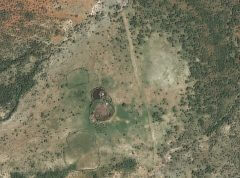"This is a dramatic paradigm shift. Until now, the perception was that herders' activity in the savanna was negative and damaged the ecosystem, and here we find that it is precisely this human activity that has been going on for thousands of years that contributes to the creation of 'green islands' that enrich and diversify the ecosystem," said Prof. Ruth Shakh-Gross, from the Department of Marine Civilizations at the University Haifa, the partner in the study published in the journal NATURE

Shepherds in the African savanna have been gathering their herds in the same places for over 3000 years, thus contributing to the enrichment of the soil and the creation of green surfaces rich in grass of high nutritional value, according to a new study published in the prestigious journal NATURE by an international team, which includes a partner from the University of Haifa. "This is a dramatic paradigm shift. Until now, the perception was that the activity of herders in the savanna was negative and harmed the ecosystem, and now we find that it is precisely this human activity that has been going on for thousands of years that contributes to the creation of 'green islands' that enrich and diversify the ecosystem," said Prof. Ruth Shakh-Gross, from the Department of Marine Civilizations at the University Haifa, the research partner.
The landscape we all know of the African savannah is of many kilometers of grasslands sparsely scattered with trees or bushes. The soils in these areas are known for their lack of nutrients and for grass with a nutritional value that is usually not high, when the migration of herds of herbivores (such as the wildebeest and zebra) is associated with the search for pastures rich in grass with a high nutritional value. But it turns out that within those grasslands, scattered in a seemingly random way are "green islands" - areas with a radius of about a hundred meters that are rich in diverse herbs, with a high nutritional value. It turns out that on these "islands" you can find archaeological sites that are several thousand years old, as well as modern herders' settlements (Maasai). The new research found that the archaeological sites were also settlement sites of shepherds, from the Neolithic period of East Africa.
In the current study, which was led by Prof. Fiona Marshall from Washington University in St. Louis, the researchers wanted to get to the bottom of those "green islands" - literally. To this end, they carried out archaeological excavations at five sites located in the "green islands" and identified stone tools, ceramics and remains of cattle and sheep bones whose age ranges from 3700 to 1550 years before our time. In order to understand the type of human activity at these sites, an innovative method developed by Prof. Shakh-Gross came into play, which allows using microscopic and chemical methods to determine whether there is evidence of animal burrows in the ancient layers, thus determining that the sites were inhabited by shepherds in the Neolithic period. "We saw in the tests that the dirt that makes up the sites - up to a time depth of 3000 years - contains the remains of farm animal dung. Later, minerals in the ancient dirt layers were tested and found to be particularly rich in phosphorus and nitrogen, the presence of which contributes to the growth of grass with a high nutritional value. In other words, the main reason for the fertility of those areas in the savannah, those "green islands", is the presence of the remains of the dung of the farm animals of the ancient herders", said Dr. Shakh-Gross.
The researchers suggest that the shepherds who thousands of years ago began gathering their herds at random points, in the savannah which was mainly composed of grasslands dotted with trees and bushes, contributed to the diversity and enrichment of this ecosystem. The dung of the herds, rich in phosphorus and nitrogen, fertilized the soil and made it fertile. After the settlements were abandoned, the area became a "green island" with particularly nutritious grass and attracted both herds of wild animals and shepherds to their herds, so that for tens, hundreds and even thousands of years, herds and shepherds returned to the same spots. As a result, these areas continue to be constantly enriched with minerals and minerals and do not deplete over time. "In the research we show that this positive feedback, which actually shaped the landscape of the savannah as we know it today, is at least 3000 years old. This makes us understand that human activity, at least in everything related to the areas we studied, has a positive and constructive effect, contrary to early opinions that held that the activity of shepherds in the savannah is harmful", concluded Prof. Shakh-Gross.
